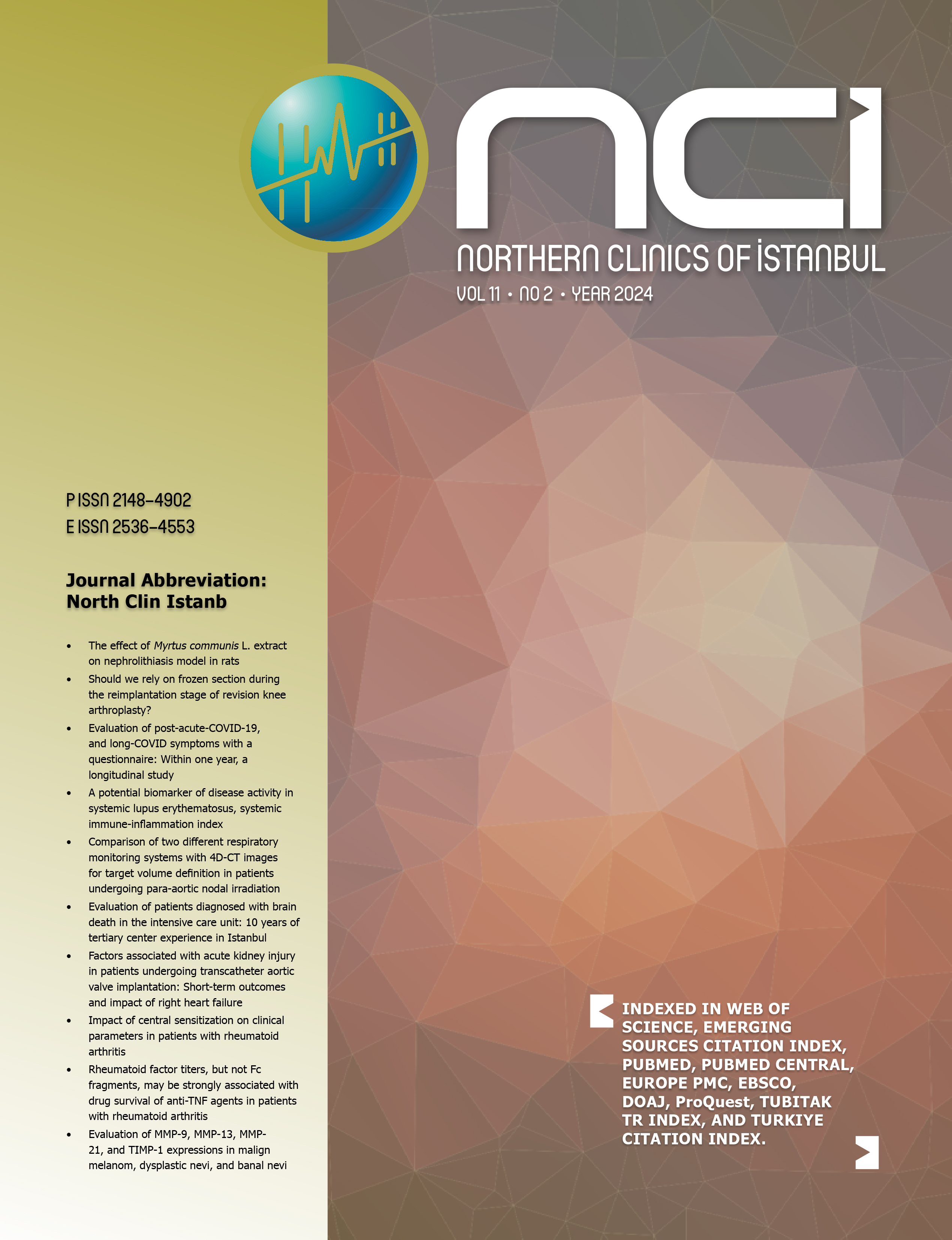Dodder (Cuscuta sp.) extract prevents cognitive deficits in a rat model of hepatic encephalopathy
Omercan Albayrak1, Bilge Nur Hatipoglu2, Dilek Ozbeyli3, Ali Sen4, Turkan Koyuncuoglu5, Ozge Cevik6, Feriha Ercan7, Fatma Kanpalta7, Ahmet Dogan8, Seren Ede Pazarbasi9, Goksel Sener101Department of Research and Development, Anatolia Geneworks, Istanbul, Turkiye2Department of Pharmacology, Marmara University Faculty of Pharmacy, Istanbul, Turkiye
3Department of Medical Services and Techniques, Marmara University Vocational School of Health Services, Istanbul, Turkiye
4Department of Pharmacognosy, Marmara University Faculty of Pharmacy, Istanbul, Turkiye
5Department of Physiology, Biruni University Faculty of Medicine, Istanbul, Turkiye
6Department of Biochemistry, Adnan Menderes University Faculty of Medicine, Aydin, Turkiye
7Department of Histology and Embriology, Marmara University Faculty of Medicine, Istanbul, Turkiye
8Department of Pharmaceutical Botany, Marmara University Faculty of Pharmacy, Istanbul, Turkiye
9Department of Pharmacy Services, Fenerbahce University Vocational School of Health Services, Istanbul, Turkiye
10Department of Pharmacology, Fenerbahce University Faculty of Pharmacy, Istanbul, Turkiye
OBJECTIVE: In our study, the protective effect of dodder plant extract against encephalopathy induced by cholestatic liver disease model was investigated.
METHODS: Spraque Dawley rats were used in the study. For the cholestatic liver disease model, the bile duct ligation (BDL) was applied. The groups were determined as control, Cuscuta sp. (CUS), BDL and BDL + CUS. Double ligation was performed in the bile duct in the BDL groups. For the applications, saline (SF) was administered to the control and BDL groups for 28 days while 250 mg/kg of Cuscuta sp. extract was given by oral gavage to the CUS and BDL + CUS groups. At the end of the experiment, cognitive evaluations were made by applying new object recognition and Morris water maze tests. After these tests, blood-brain barrier (BBB) measurements were made in half of the groups. In the other half of the groups, brain tissue samples were taken by decapitation and transforming growth factor-beta (TGF-β), 8-hydroxydeoxyguanosine (8-OHdG) and sodium-potassium adenosine triphosphatase (Na+/K+-ATPase) measurements were made in the tissues. Histological examinations of the tissues were also performed.
RESULTS: Cognitive performance was low, and BBB permeability was found to be increased in the group with bile duct ligation. In addition, TGF-β and 8-OHdG levels were increased in tissues, while Na+/K+-ATPase enzyme activity was suppressed. Treatment with Cuscuta sp. increased cognitive performance and decreased BBB permeability. Other biochemical parameters examined were significantly (p<0.050.001) reversed and supported by histological findings.
CONCLUSION: Our findings in the study suggest that dodder plant may be beneficial for the protection of cognitive performance and brain tissue in encephalopathy caused by cholestasis.
Keywords: Cuscuta sp.; cholestasis; encephalopathy; fibrosis.
Dodder (Cuscuta sp.) ekstresinin sıçanlarda hepatik ensefalopati modelinde bilişsel fonksiyonları koruyucu etkisi
Omercan Albayrak1, Bilge Nur Hatipoglu2, Dilek Ozbeyli3, Ali Sen4, Turkan Koyuncuoglu5, Ozge Cevik6, Feriha Ercan7, Fatma Kanpalta7, Ahmet Dogan8, Seren Ede Pazarbasi9, Goksel Sener101Araştırma ve Geliştirme Bölümü, Anatolia Geneworks, İstanbul2Marmara Üniversitesi Eczacılık Fakültesi, Farmakoloji Anabilim Dalı, İstanbul
3Marmara Üniversitesi Sağlık Hizmetleri Meslek Yüksekokulu, Tıbbi Hizmetler ve Teknikler Bölümü, İstanbul
4Marmara Üniversitesi Eczacılık Fakültesi, Farmakognozi Anabilim Dalı, İstanbul
5Biruni Üniversitesi Tıp Fakültesi, Fizyoloji Anabilim Dalı, İstanbul
6Adnan Menderes Üniversitesi Tıp Fakültesi, Biyokimya Anabilim Dalı, Aydın
7Marmara Üniversitesi Tıp Fakültesi, Histoloji ve Embriyoloji Anabilim Dalı, İstanbul
8Marmara Üniversitesi Eczacılık Fakültesi, Farmasötik Botanik Anabilim Dalı, İstanbul
9Fenerbahçe Üniversitesi Sağlık Hizmetleri Meslek Yüksekokulu, Eczane Hizmetleri Bölümü, İstanbul
10Fenerbahçe Üniversitesi Eczacılık Fakültesi, Farmakoloji Anabilim Dalı, İstanbul
Amaç: Çalışmamızda kolestatik karaciğer hastalığı modelinde gelişen ensefalopatide Küsküt otu ekstresinin koruyucu etkisi incelendi.
Gereç ve Yöntem: Çalışmada Spraque Dawley sıçanlar kullanıldı. Kolestatik karaciğer hastalığı modeli için safra kanalı bağlandı (SKB). Gruplar, kontrol, Küsküt (KÜS), SKB ve SKB + KÜS olarak belirlendi. SKB gruplarında safra kanalında çift ligasyon yapıldı. Uygulamalar için 28 gün süresince, kontrol ve SKB gruplarına serum fizyolojik (SF); KÜS ve SKB + KÜS gruplarına 250 mg/kg Küsküt otu ekstresi oral gavaj ile verildi. Deney sonunda yeni obje tanıma ve Morris su labirent testleri uygulanarak bilişsel değerlendirmeler yapıldı. Bu testlerin ardından grupların yarısında kan beyin bariyeri (KBB) ölçümü yapıldı. Grupların diğer yarısında ise dekapitasyon ile beyin doku örnekleri alındı ve dokularda transforme edici büyüme faktör-beta (TGF-β), 8-hidroksideoksiguanozin (8-OHdG) ve sodyum-potasyum adenozin trifosfataz (Na+/K+-ATPaz) ölçümleri yapıldı. Dokuların ayrıca histolojik incelemeleri de yapıldı.
Bulgular: Safra kanalı bağlanan grupta bilişsel performans düşük ve KBB geçirgenliği artmış olarak bulundu. Ayrıca dokularda TGF-β ve 8-OHdG düzeyleri yükselmiş, Na+/K+-ATPaz enzim aktivitesi ise baskılanmıştır. Küsküt ile yapılan tedavi bilişsel performansı artırmış, KBB geçirgenliğini azaltmıştır. İncelenen diğer biyokimyasal parametreler anlamlı derecede (p<0,05-0,001) tersine çevrilmiş ve histolojik bulgular ile desteklenmiştir.
Sonuç: Çalışmada elde edilen bulgularımız Küsküt otunun kolestazın neden olduğu ensefalopatide bilişsel performans ve beyin dokusunun korunması yönünde faydalı olabileceği düşündürmektedir. (NCI-2023-9-2)
Anahtar Kelimeler: Küsküt; kolestaz; ensefalopati; fibroz.
Manuscript Language: English





















